Related Research Articles
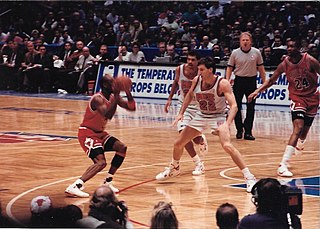
Basketball is a team sport in which two teams, most commonly of five players each, opposing one another on a rectangular court, compete with the primary objective of shooting a basketball through the defender's hoop, while preventing the opposing team from shooting through their own hoop. A field goal is worth two points, unless made from behind the three-point line, when it is worth three. After a foul, timed play stops and the player fouled or designated to shoot a technical foul is given one, two or three one-point free throws. The team with the most points at the end of the game wins, but if regulation play expires with the score tied, an additional period of play (overtime) is mandated.

Abraham Michael Saperstein was the founder, owner and earliest coach of the Harlem Globetrotters. Saperstein was a leading figure in black basketball and baseball from the 1920s through the 1950s, primarily before those sports were racially integrated.

In basketball, the basketball court is the playing surface, consisting of a rectangular floor, with baskets at each end. Indoor basketball courts are almost always made of polished wood, usually maple, with 10 feet (3.048 m)-high rims on each basket. Outdoor surfaces are generally made from standard paving materials such as concrete or asphalt. International competitions may use glass basketball courts.
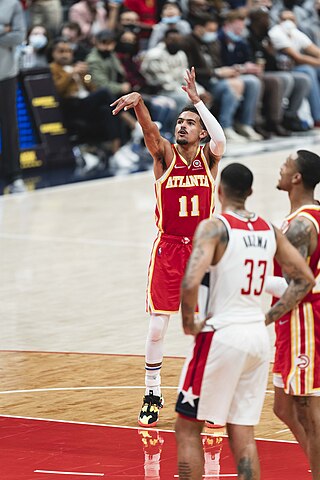
In basketball, free throws or foul shots are unopposed attempts to score points by shooting from behind the free-throw line, a line situated at the end of the restricted area. Free throws are generally awarded after a foul on the shooter by the opposing team, analogous to penalty shots in other team sports. Free throws are also awarded in other situations, including technical fouls, and when the fouling team has entered the bonus/penalty situation. Also, depending on the situation, a player may be awarded between one and three free throws. Each successful free throw is worth one point.
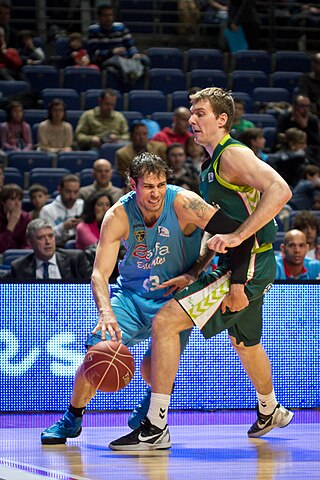
In basketball, a personal foul is a breach of the rules that concerns illegal personal contact with an opponent. It is the most common type of foul in basketball. A player fouls out on reaching a limit on personal fouls for the game and is disqualified from participation in the remainder of the game.

The rules of basketball are the rules and regulations that govern the play, officiating, equipment and procedures of basketball. While many of the basic rules are uniform throughout the world, variations do exist. Most leagues or governing bodies in North America, the most important of which are the National Basketball Association and NCAA, formulate their own rules. In addition, the Technical Commission of the International Basketball Federation (FIBA) determines rules for international play; most leagues outside North America use the complete FIBA ruleset.

In basketball, there are five players on court per team, each assigned to positions. Historically, these players have been assigned to positions defined by the role they play on the court, from a strategic point of view. The three main positions are guard, forward, and center, with the standard team featuring two guards, two forwards, and a center. Over time, as more specialized roles developed, each of the guards and forwards came to be differentiated, and today each of the five positions is known by a unique name and number: point guard (PG) or 1, the shooting guard (SG) or 2, the small forward (SF) or 3, the power forward (PF) or 4, and the center (C) or 5 "post position".
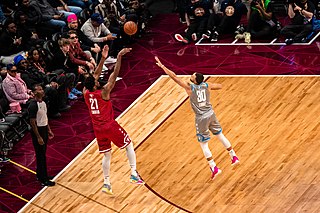
A three-point field goal is a field goal in a basketball game made from beyond the three-point line, a designated arc surrounding the basket. A successful attempt is worth three points, in contrast to the two points awarded for field goals made within the three-point line and the one point for each made free throw.

In timed sports, a buzzer beater is a successful shot that upon completion leaves zero seconds on the game clock. A buzzer sounds whenever a game clock expires, hence the name "buzzer beater". In basketball, the concept normally applies to baskets that beat an end-of-quarter/2nd-half/overtime buzzer but is sometimes applied to shots that beat the shot clock buzzer.

This glossary of basketball terms is a list of definitions of terms used in the game of basketball. Like any other major sport, basketball features its own extensive vocabulary of unique words and phrases used by players, coaches, sports journalists, commentators, and fans.
A half-court shot is a shot taken from beyond the 3-pointer line as defined by a semicircular line before the 2-pointer zone. Anything beyond the half-court line and on the side of the court a team or player is defending is considered a full-court shot. It is most commonly used as a buzzer beater as there is a limited amount of time before a turnover. It is also used as a streetball term where the teams only use half of the full court. The most common backcourt shot style is known as "the Runner". If the shooter has a few seconds to spare, "the Runner" can be used to shorten the distance to the rim while also adding extra power to the shot. Other backcourt shot styles include: "the Sheed" ; "the Contested Prayer"; and "the Zoran". Since an NBA game court is 94 feet (29 m) long, the midcourt line is 47 feet (14 m) away from each baseline.
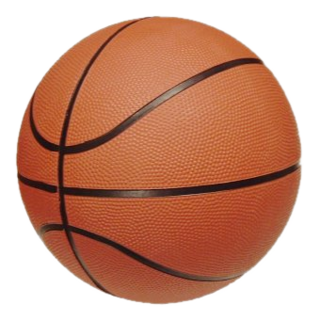
A basketball is a spherical ball used in basketball games. Basketballs usually range in size from very small promotional items that are only a few inches in diameter to extra large balls nearly 2 feet (60 cm) in diameter used in training exercises. For example, a youth basketball could be 27 inches (69 cm) in circumference, while a National Collegiate Athletic Association (NCAA) men's ball would be a maximum of 30 inches (76 cm) and an NCAA women's ball would be a maximum of 29 inches (74 cm). The standard for a basketball in the National Basketball Association (NBA) is 29.5 inches (75 cm) in circumference and for the Women's National Basketball Association (WNBA), a maximum circumference of 28.5 inches (72 cm). High school and junior leagues normally use NCAA, NBA or WNBA sized balls.

In basketball, a field goal is a basket scored on any shot or tap other than a free throw, worth two or three points depending on the location of the attempt on the basket. Uncommonly, a field goal can be worth other values such as one point in FIBA 3x3 basketball competitions or four points in the BIG3 basketball league. "Field goal" is the official terminology used by the National Basketball Association (NBA) in their rule book, in their box scores and statistics, and in referees' rulings. The same term is also the official wording used by the National Collegiate Athletic Association (NCAA) and high school basketball.

The key, officially referred to as the free throw lane by the National Basketball Association (NBA), the National Collegiate Athletic Association (NCAA), the National Association of Intercollegiate Athletics (NAIA), and the National Federation of State High School Associations (NFHS), and the restricted area by the International Basketball Federation (FIBA), also simply called the lane, is a marked area on a basketball court surrounding the basket, where much of the game's action takes place.
Four-pointer may refer to:
In basketball, a four-point play is the rare occasion when an offensive player shoots and makes a three-point field goal while simultaneously being fouled by a defensive player, resulting in a shooting foul and one free throw attempt, or a two-point field goal and is intentionally or flagrantly fouled on the shot and is awarded two free throws. If the player makes their free throws, they will have scored four points on a single possession. The short-lived American Basketball League first introduced the four-point play to the game of basketball, and it was later adopted by the American Basketball Association during its inaugural season. The National Basketball Association (NBA) introduced that rule in 1979; FIBA in 1984; the NCAA in 1986 and 1987 (women); the NHFS in 1987; and the WNBA in 1997.
The NBA All-Star Celebrity Game is an annual exhibition basketball game held by the National Basketball Association that takes place during the NBA All-Star Weekend and features retired NBA players, WNBA players, actors, musicians and athletes from sports other than basketball.
Basketball is a ball game and team sport in which two teams of five players try to score points by throwing or "shooting" a ball through the top of a basketball hoop while following a set of rules. Since being developed by James Naismith as a non-contact game that almost anyone can play, basketball has undergone many different rule variations, eventually evolving into the NBA-style game known today. Basketball is one of the most popular and widely viewed sports in the world.
Basketball is a team sport in which two teams of five players try to score points by throwing or "shooting" a ball through the top of a basketball hoop while following a set of rules. Basketball is one of the most popular and widely viewed sports in the world.

Big3 is a 3-on-3 basketball league founded by hip-hop musician and actor Ice Cube and entertainment executive Jeff Kwatinetz. The league consists of 12 teams whose rosters include both former NBA players and international players. The rules of Big3 games contain deviations from the official rules of 3-on-3 basketball as administered by FIBA. In January 2020, Big3 announced its rule set would be the core of a new basketball variant called "Fireball3".
References
- ↑ "Going deep: Harlem Globetrotters add a four-point line". USA TODAY. Retrieved 2023-06-26.
- ↑ "BIG3: Mike Bibby hits pair of 4-pointers as Ice Cube's league makes its debut". USA TODAY. Retrieved 2023-06-26.
- ↑ Mather, Victor (2017-01-12). "New Three-on-Three League Has a 4-Point Shot, and Allen Iverson". The New York Times. ISSN 0362-4331 . Retrieved 2023-06-26.
- ↑ "BIG3 Rules". Archived from the original on 2017-07-24. Retrieved 2017-07-04.
- ↑ "ABA History and Unique Rules". Indiana Lyons. August 28, 2018. Retrieved July 1, 2023.
- ↑ "2023 WNBA All-Star Game: Time, date, TV channel, rosters, starting lineups, weekend schedule, live stream". CBSSports.com. 2023-07-15. Retrieved 2023-10-23.
- ↑ Ramos, Gerry (July 22, 2024). "PBA officially adopts four-point shot for next season". Spin.ph. Retrieved July 22, 2024.